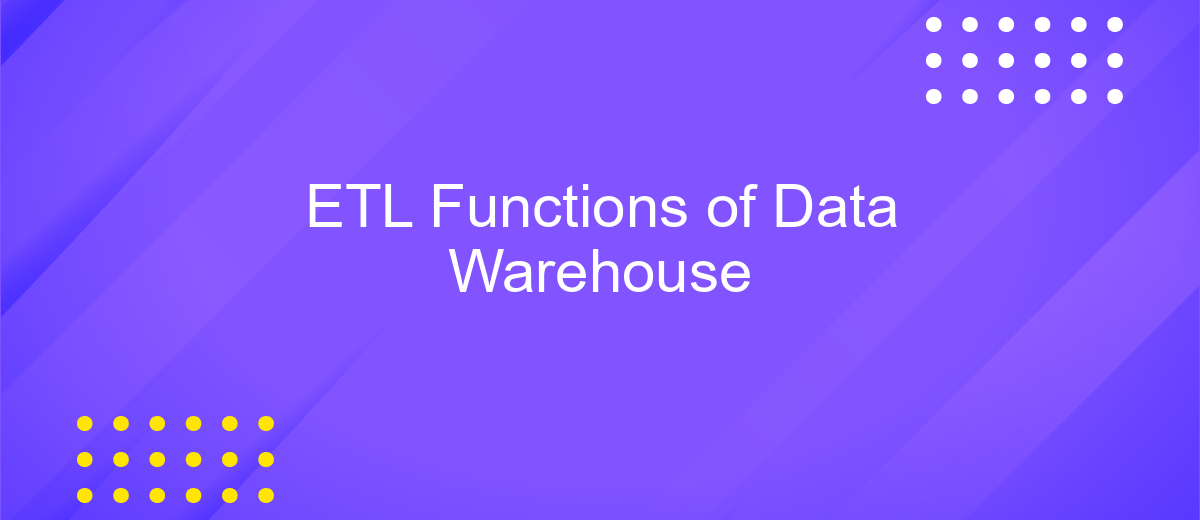ETL Functions of Data Warehouse
ETL (Extract, Transform, Load) functions are critical components of a data warehouse, enabling the seamless integration of data from various sources. These processes ensure that data is accurately extracted, appropriately transformed, and efficiently loaded into the data warehouse for analysis. Understanding ETL functions is essential for optimizing data management and enhancing the decision-making capabilities of organizations.
Introduction
In the ever-evolving landscape of data management, ETL (Extract, Transform, Load) functions are critical for the efficient operation of data warehouses. These functions enable organizations to consolidate data from various sources, transform it into a meaningful format, and load it into a data warehouse for analysis and reporting. ETL processes ensure that data is accurate, consistent, and ready for business intelligence tasks.
- Extract: Gathering data from multiple, often disparate sources.
- Transform: Converting data into a usable format, which may involve cleaning, aggregating, and validating.
- Load: Inserting the transformed data into the target data warehouse.
Services like ApiX-Drive simplify the integration process by automating data extraction from various platforms and applications, ensuring seamless data flow into your ETL pipeline. By leveraging such tools, organizations can significantly reduce the complexity and time required to set up and maintain their data integration processes, allowing them to focus more on data analysis and decision-making.
Data Extraction

Data extraction is the first crucial step in the ETL (Extract, Transform, Load) process, where raw data is collected from various sources. These sources can include databases, web services, flat files, or cloud-based storage systems. The primary goal of data extraction is to gather accurate and relevant data without altering the original source. This process ensures that the data is ready for subsequent transformation and loading into the data warehouse. Effective extraction methods are essential to maintain data integrity and consistency, which are fundamental for reliable analytics and decision-making.
Modern data extraction tools and services, such as ApiX-Drive, simplify the integration of various data sources. ApiX-Drive offers a user-friendly interface and automated workflows that facilitate seamless data extraction from multiple platforms. By leveraging such services, organizations can streamline their data collection processes, ensuring that data is continuously and accurately extracted. This automated approach not only saves time but also reduces the risk of errors, making it easier to manage and utilize large volumes of data for business intelligence and analytics.
Data Transformation

Data transformation is a crucial step in the ETL process of a data warehouse. It involves converting raw data into a format that is suitable for analysis and reporting. This transformation process ensures that data from various sources can be integrated seamlessly, providing a unified view of information.
- Data Cleaning: This step involves removing inconsistencies and inaccuracies from the data. It includes handling missing values, correcting errors, and filtering out irrelevant information.
- Data Normalization: This process standardizes data to ensure consistency. It involves converting data into a common format, making it easier to compare and analyze.
- Data Aggregation: This step summarizes detailed data into more manageable forms. Aggregation can include operations such as summing, averaging, or counting data points.
- Data Enrichment: This involves enhancing the data with additional information. For instance, integrating data from external sources like ApiX-Drive can provide more context and improve data quality.
Effective data transformation ensures that the data warehouse contains clean, consistent, and enriched data, which is essential for accurate and insightful analytics. By leveraging tools like ApiX-Drive, organizations can automate and streamline the data integration process, making it more efficient and reliable.
Data Loading

Data loading is a crucial step in the ETL process, where transformed data is loaded into the data warehouse for further analysis and reporting. This phase ensures that the data is accurately and efficiently transferred to the target system, maintaining data integrity and consistency.
To achieve seamless data loading, it is essential to use reliable tools and techniques. Various methods can be employed, such as bulk loading, incremental loading, and real-time loading, each catering to different business needs and data volumes. Proper scheduling and monitoring of the data loading process are also vital to avoid any disruptions and ensure timely availability of data.
- Bulk Loading: Suitable for large datasets, this method transfers data in large chunks, reducing the number of transactions.
- Incremental Loading: This method updates only the changed or new data, optimizing performance and reducing load times.
- Real-Time Loading: Enables continuous data updates, providing up-to-date information for real-time analytics.
Using integration services like ApiX-Drive can significantly streamline the data loading process. ApiX-Drive offers easy-to-configure integrations, allowing businesses to automate data transfers between various sources and the data warehouse. This not only saves time but also minimizes errors, ensuring a smooth and efficient data loading experience.


Conclusion
The ETL functions of a data warehouse are crucial for ensuring the efficient processing and transformation of raw data into valuable insights. By extracting data from various sources, transforming it into a suitable format, and loading it into the data warehouse, organizations can streamline their data management processes and enhance decision-making capabilities. These functions not only improve data quality and consistency but also enable businesses to respond more swiftly to market changes and customer demands.
Moreover, integrating ETL processes with advanced automation tools like ApiX-Drive can further optimize data workflows. ApiX-Drive simplifies the integration of various data sources and automates routine tasks, reducing the need for manual intervention and minimizing errors. This enhances the overall efficiency of the data warehouse, allowing organizations to focus more on data analysis and strategic planning. In conclusion, the effective implementation of ETL functions, complemented by robust integration tools, is essential for maximizing the potential of a data warehouse and driving business success.
FAQ
What is ETL in the context of a data warehouse?
Why is ETL important for data warehousing?
What are some common challenges in ETL processes?
How often should ETL processes be run?
Can ETL processes be automated?
Time is the most valuable resource in today's business realities. By eliminating the routine from work processes, you will get more opportunities to implement the most daring plans and ideas. Choose – you can continue to waste time, money and nerves on inefficient solutions, or you can use ApiX-Drive, automating work processes and achieving results with minimal investment of money, effort and human resources.

